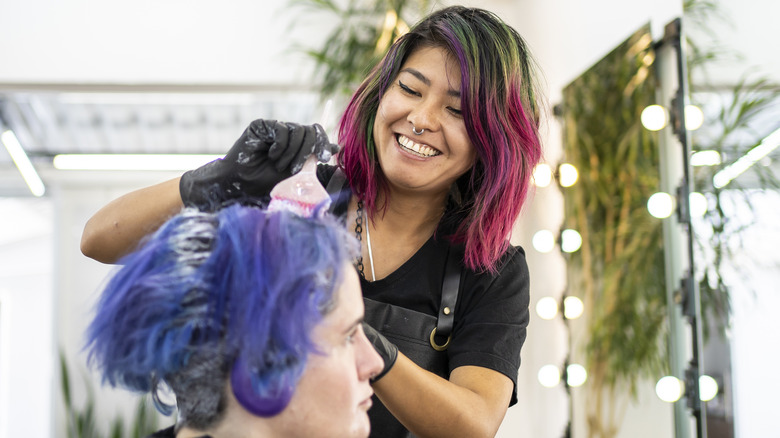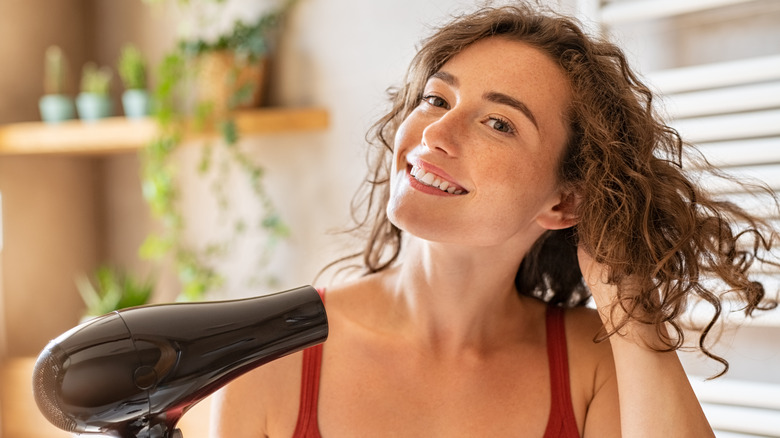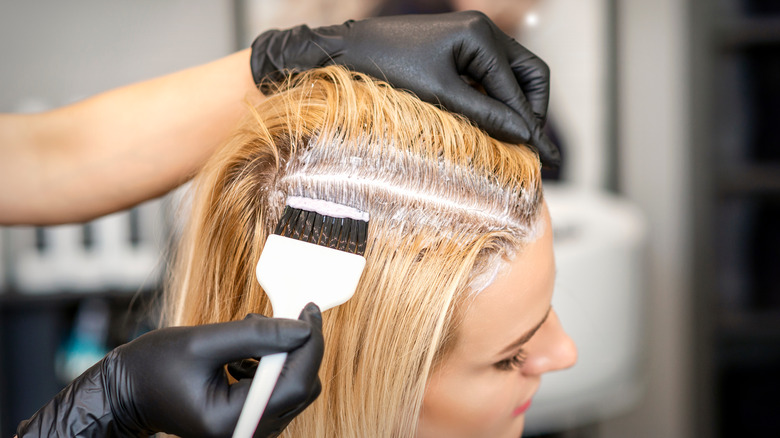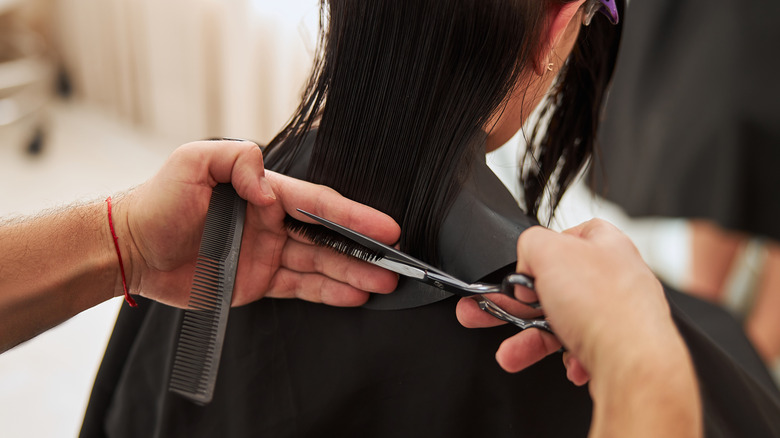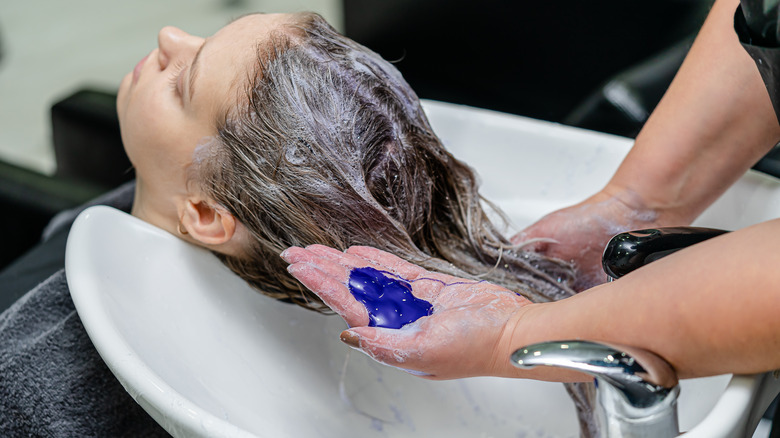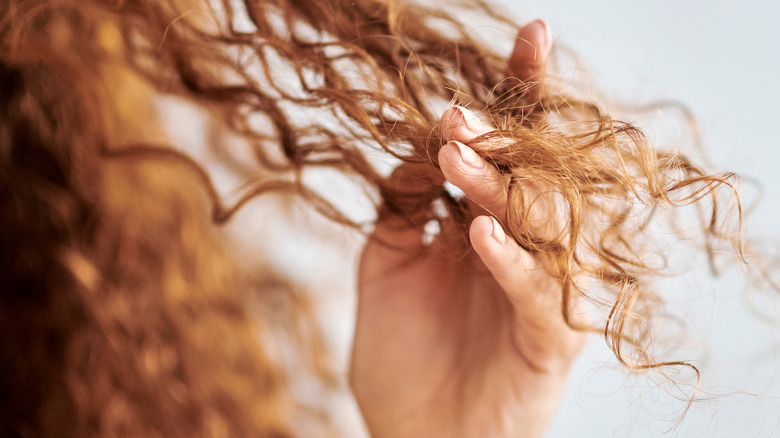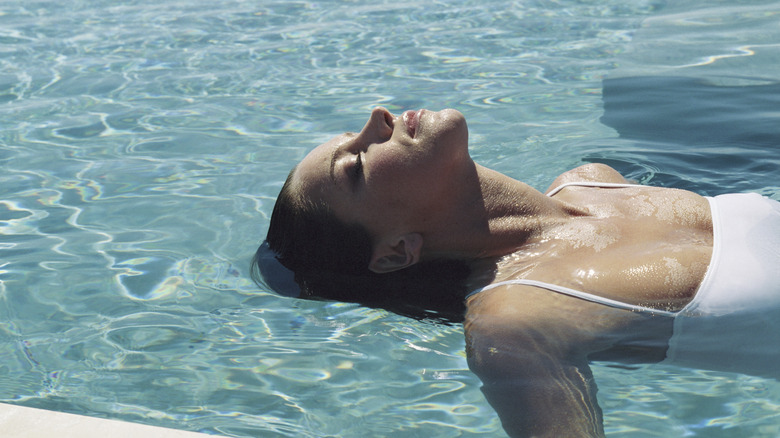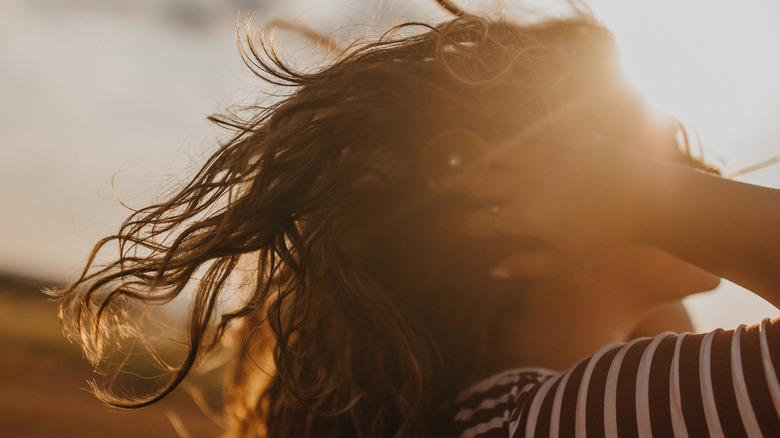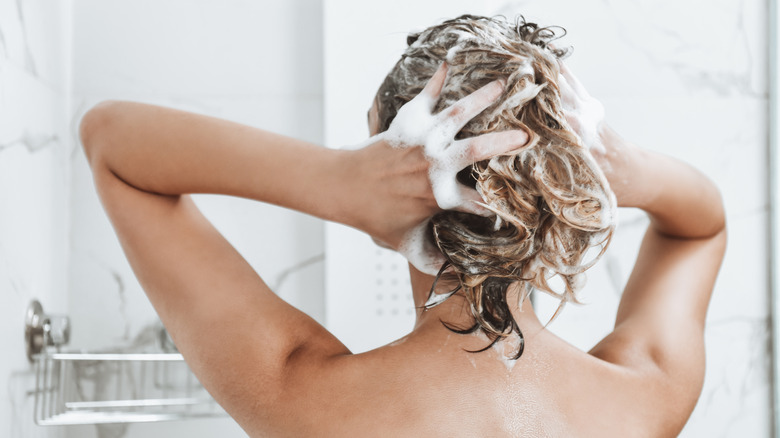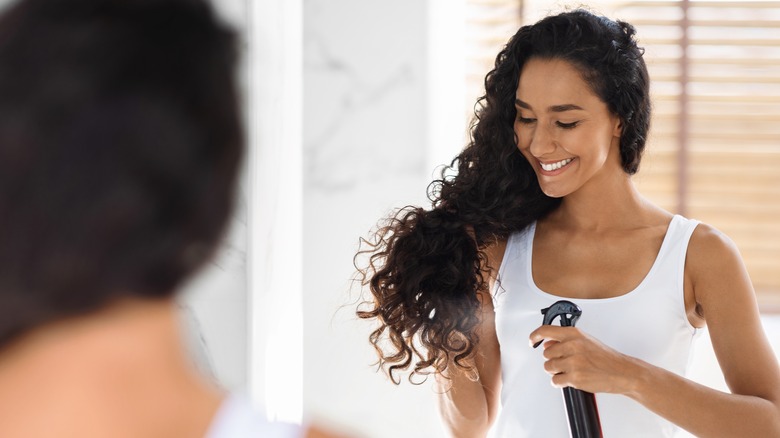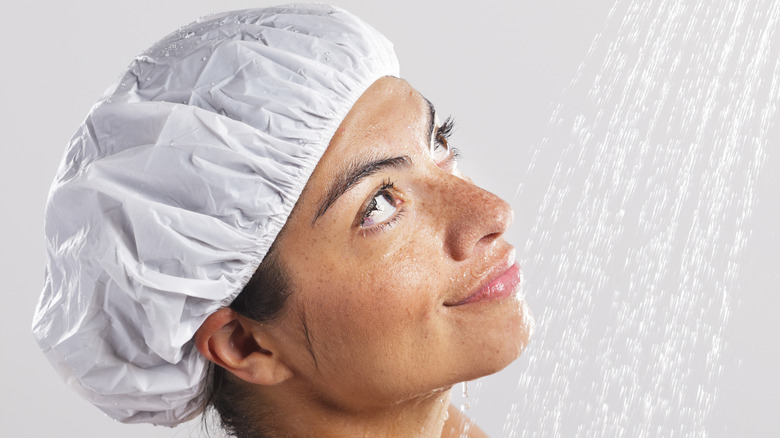11 Mistakes That Could Damage Color-Treated Hair
There are dozens of reasons to experiment with hair color. Perhaps you're not ready to embrace graying hair and want to cover up those roots. Maybe you like to lighten or darken your hair in accordance with the season or try out vibrant colors to showcase your personality. Some believe that it can even be healthy to change your natural color. "Coloring your hair can have benefits, such as sealing down the cuticle for healthier looking hair," color and styling expert Nina Farrauto told Elle. "Hair can also appear more full with a fresh color." No matter why you choose to color your hair, if you pay a stylist between $70 and $200 to work their magic, the odds are that you want it to last longer than a day.
No matter beautiful your hair looks fresh out of the salon chair, there are a number of ways you can accidentally damage it or shorten the life of your color once you get home. Colored-treated hair is fragile due to the use of harsh chemicals like ammonia and peroxide, which lift natural hair's pigment and deposit permanent color into each strand. "These chemicals permanently break down certain bonds in the hair structure and cause the hair to become weaker and more fragile," celebrity stylist Stacey Ciceron explained to InStyle. Whether you use too much heat or don't use color-safe products, making the following mistakes can cause problems and put your colored hair at risk of permanent damage.
Going too hard with the heat
Using too much heat on colored hair is a mistake guaranteed to fade color and increase damage. Styling tools like hair dryers, straighteners, and curling irons cause dyed hair to dry out more quickly. The end result is often brittle, broken, and frizzy hair. At the same time, heat styling tools can also cause hair color to fade and even oxidize, leading to brassy hair that requires special treatments at home or the salon to correct.
Before you toss your hair dryer or beloved curling iron in the bin, know that heat styling tools can be used on color-treated hair in moderation. Waiting up to three days after a fresh color to blow dry your hair is advisable to minimize initial damage. Being mindful of the temperature you set your styling tools to is also important. Depending on the texture of your hair, keeping your tools set between 200 and 300 degrees Fahrenheit is recommended. You should also incorporate heat-protectant products into your styling routine to protect the weakened outer layers of each strand before applying heat.
Taking the occasional break from heat styling is also helpful for prolonging the life of your colored hair. "Try your best to reduce the amount of artificial heat on the hair by letting hair air-dry naturally a couple of days a week, or using styling hacks to style hair without any heat," celebrity hairstylist Lee Stafford recommended to New Beauty.
Dyeing your hair too frequently
Changing up your hair color can be addicting, especially because there are no hard rules about how frequently you can dye your hair. If you like to change up your look on a whim, adding a new hair color is a fun way to go about it. However, too much of a good thing can lead to bad results. If you dye your hair too often in shades that require bleach or permanent dyes, you may eventually experience dry, frizzy, damaged hair. Furthermore, it could require weeks of care and hundreds of dollars to restore. The exact length of time you'll need to wait between dye jobs depends on your hair's texture and health, but the general period is between four to 10 weeks.
Certain types of hair dye are safer than others for quick color changes. Temporary dye is the mildest option that typically washes out after a shampooing or two. This can be used more frequently and is ideal if you like to experiment with different colors. Semi-permanent dyes do not contain peroxide — the chemical necessary for lifting and lightening — and usually rinse out after around six washes. "Semi-permanent hair dye can be done every week, since it does not penetrate your hair," hairstylist Ashley Mitchell told Healthline. Demi-permanent and permanent hair dyes are safe to use once every six to eight weeks, although the true frequency is dependent on your hair's natural texture, growth rate, and health.
Skipping hair trims
It is important not to skip hair trims if you color your hair. Stylists generally recommend getting your hair trimmed every six to 12 weeks, with certain styles and textures having a grace period of up to six months. It is a common hair care myth that frequent trims will make your hair grow faster, but coloring your hair can put stress on the ends and over-process them. This may require more frequent trips to the salon to keep the ends looking fresh.
With such a big recommended window of time, how do you know when it's time to get your colored hair trimmed while maintaining your preferred length and style? "If your hair is more prone to split ends or you have a lot of chemical treatments done, trimming every eight weeks will help your hair healthy," celebrity stylist Creighton Bowman told Byrdie. Additionally, other experts seem to agree. In an interview with Marie Claire, everyone's favorite hair expert, Jonathan Van Ness, noted that "...a good haircut always makes hair color look better!"
Skimping on products formulated for colored hair
One of the biggest mistakes you can make while caring for your color-treated hair is skimping on hair products formulated specifically for dyed hair. It can be tempting to opt for cheaper or familiar hair products after spending a lot of money getting your hair colored. If you want to protect that investment for as long as possible, however, it's best to use color-safe hair products. "To maintain color-treated hair, it's best to avoid sulfate-based shampoo, sodium chloride, and parabens," celebrity hair colorist Bianca Hillier told SheFinds. These ingredients have their purpose, but they can lead to irritation and dehydration that damages and fades colored hair. "Instead, it is best to use a color-safe shampoo to maintain the color and health in the hair," Hillier added.
Color-safe shampoos and conditioners are designed without harsh ingredients, like sulfates and parabens. These can increase damage and strip the color deposits from your hair. Many contain hydrating, moisture-preserving oils and vitamins vital for hair health, like biotin. If you spend a lot of time outdoors or in the pool, look for a color-safe shampoo and conditioner duo that protects against environmental aggressors and hard water. The use of color-safe, color-correcting products can even fix and prevent brassy hair.
Not giving your hair a protein boost
Not using color-safe shampoo and conditioner isn't the only hair product mistake you can make with colored hair. After putting your hair through the drying, damaging process of dyeing, you have to give it what it needs to stay strong, soft, and shiny. Giving hair a protein boost in the form of a high-quality hair mask is key to locking in much-needed moisture and nourishing parched strands. "If you are battling damaged hair from coloring or chemical treatments, you'll want to look for a protein-rich mask that will help make your hair strong again," celebrity stylist Graham Nation told WhoWhatWear.
Protein is an essential building block of hair, with roughly 95% of each strand made up of the protein keratin. Applying a mask rich in keratin alongside shea butter, jojoba oil, and other moisturizing ingredients can revitalize the damaged structures. "Protein will help to rebuild bonds and keep hair from breaking, while moisture will replenish the hair and keep it from feeling and looking overly dry," stylist Dana Hodges told Shape. In addition to regular at-home hair masks, drinking plenty of water and eating a well-balanced diet can give your hair the boost it needs to combat dye damage.
Going swimming
Chlorine and salt water are damaging to all hair. However, if you have colored hair and don't take the proper protective steps, a leisurely swim can put it at an increased risk for fading, dehydration, and breakage. Chlorine, in particular, is effective in purifying water, but it breaks down the amino acids in your hair. This can cause damage and draw out artificial color, along with melanin and sebum in virgin hair. Salt water, on the other hand, draws out the hair's natural moisture. It interacts with the cuticle, causing split ends and dull, lifeless color.
You can take steps to protect your freshly colored hair from the devastating effects of chlorine. A swimming cap is an ideal choice for keeping your hair out of the water, especially if you like to swim laps. In situations where a swim cap isn't ideal, coating your hair with a moisturizing agent, like coconut oil, can form a barrier between your fragile hair and the harsh chemicals in the pool water. Rinsing your hair prior to cannonballing into the pool is also recommended. "This trick lets your hair absorb less chlorine, or salt water if you're dipping in the ocean," celebrity colorist Lorri Goddard explained to Glamour. "Then give it another rinse after you're done swimming." Be sure to apply your color-safe conditioner to the ends of your hair to restore any lost moisture caused by the pool or ocean water.
Not protecting your hair from the sun
Everyone knows the importance of protecting your skin from the sun's harmful ultraviolet (UV) rays. However, protecting your hair from the sun is of equal importance, particularly if you have recently dyed your hair. Research has shown that UVB rays irreparably damage hair protein structures, while the radiation from UVA rays is responsible for changes in color. Both affect the protective outer layer of hair and are instrumental in causing weak, brittle, brassy tresses. "The sun can change the color of your hair by degrading the natural pigment known as melanin, causing the color to fade," hair colorist George Papanikolas warned while speaking to Makeup.com by L'Oréal. "Artificial hair is more delicate and fades faster with sun exposure, typically leaving you with unwanted tones." People with fine blonde or red hair are typically more at risk of experiencing these side effects.
Accessories that create physical barriers like wide-brimmed hats and umbrellas are the best ways to protect your hair and scalp from the sun. Limiting your time outside during the hottest, sunniest times of the day is also a good idea. If you have to be in the sun, you can invest in hair products that contain UV filters. Although your hair doesn't need the same SPF that your skin needs, UV filters can help limit the amount of sun your strands absorb. These protective hair products typically contain argan or sunflower seed oils for a boost in moisture.
Rinsing with hot water
Hot showers are one of life's great pleasures, but if you recently had your hair dyed, it's best to skip the hot water rinse. Hot water may be ideal for washing your hair, but it dries out your scalp. Like heat styling tools, hot water is also a major contributor to fading color. This occurs when warmer temperatures open up the cuticle and leech it of color in addition to drying out the strand. "When hot water is used to wash hair, your hair follicles are exposed to environmental and oxidative damage, which can lead to hair fall," dermatologist Hasan Benar tells Byrdie. "Hair fall accelerates due to the loosened grip of the damaged hair roots. This can also result in premature graying."
You may be tempted to go in the opposite direction and shower in ice-cold water, but the answer lies somewhere in the middle. Although there are positives to rinsing with cold water, such as preserving your hair's natural oils and potentially improving blood circulation within the scalp, cold water can contribute to flat, greasy-looking tresses. Lukewarm water is the ideal temperature for rinsing your colored hair. It is warm enough to help cleanse the scalp and hair of dirt, grime, and product, but not so hot it will cause fading or damage.
Using alcohol-based hair products
Using hair products with certain types of alcohol in them is a surefire way to increase the dryness and frizziness of your hair. Untreated hair is normally unaffected by aromatic, fatty, or secondary alcohols found in products, like hairspray or dry shampoo. When combined in trace amounts with other beneficial, moisturizing ingredients, they typically don't have the power to dry out hair.
Short-chain alcohols are a different story, especially if you have color-treated hair. Often listed as propanol or ethanol in the ingredients list, these alcohols evaporate quickly, a feature designed to keep the product from sitting wetly on your hair. Unfortunately, they don't stop there. "This alcohol also wicks moisture away from the hair and scalp," chemist Dr. Joe Cincotta shared with Color Wow. "So while the styling agents attach faster and work better (like many heavy-duty hairsprays) your hair is literally getting sucked dry." To be on the safe side, it is a good idea to research different alcohol-free products designed to protect color and work with your hair type.
Using medicated shampoos
Prescribed by a doctor or dermatologist, medicated shampoos are ideal for conditions like thinning hair, seborrheic dermatitis, and dandruff. However, these products typically contain harsh active ingredients like salicylic acid and ketoconazole. When used as prescribed, these active ingredients and their antifungal properties can target the bacteria that cause dandruff. Unfortunately, they can also contribute to hair breakage, dryness, and discoloration, turning your recent color treatment into a faded memory.
If you have to use a medicated shampoo to manage a particular condition, you shouldn't stop using it just to protect your hair color. Rinsing your hair before shampooing may help the strands from absorbing the harsh ingredients and drying out. Don't be afraid to discuss the matter with your stylist or colorist as well. They may have good recommendations for medicated products that are color-safe. In an interview with Well+Good, hair care brand founder Alex Adler recommended paying attention to the ingredients in whatever products you consider above all else. "Using a dandruff shampoo that isn't formulated to be color-safe could result in your color treatment fading, stripping, or depending on the shade, turning brassy."
Washing your color-treated hair too frequently
If you are new to the world of hair color and care, knowing when to wash your hair after getting it colored can cause confusion. Most experts agree that you should wait to wash your freshly dyed hair for a minimum of 48 to 72 hours. This time frame is thought to allow the pigments to settle into the cuticle properly, prolonging the depth and vibrancy of your new color and avoiding premature fading from subsequent washes.
However, others believe preserving fresh hair color is less about the time you wait to wash it and more about the number of times you shampoo in the weeks post-color. Hairstylist Chase Kusero noted to Vogue that "...extending the time in between washing to allow your hair to retain more of its natural oils." "Washing too frequently can also affect color-treated hair and cause it to dull and fade much faster," Kusero added.
Ultimately, if you're unsure about what advice to follow, consult with your colorist. They will have the best understanding of your hair type and how well it holds onto color. They can give you personalized recommendations for washing and aftercare.
